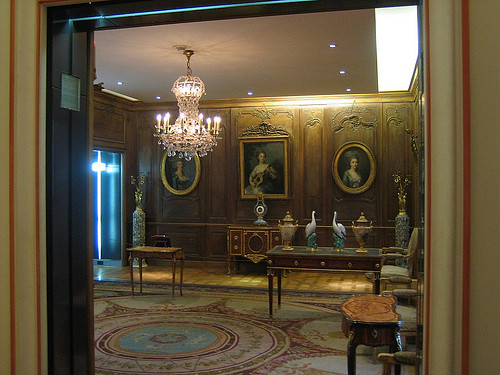
What interested me most were works by Antoine Watteau, and my favorite was a study, titled Etudes de deux figures de femmes (Study of two female figures). The line drawing was fluid, with just enough detail to give the figure a three-dimensional modeling, without overwhelming the figure with large hatching, therefore losing the trademark delicacy of the artist. The figures were either aristocrats or actresses caught in their moonlit performances, a favored setting by this peculiar painter.

Etudes de deux figures de femmes, Antoine Watteau
My second favorite was an oil painting, a portrait of Gaspard Gevartius (an Antwerp city clerk) by Peter Paul Rubens.

Gaspard Gevartius, Peter Paul Rubens
This painting is very similar to another portrait of Gevartius by Rubens, collected in Antwerpen Koninklijk Museum voor Schone Kunsten. Instead of giving him a writing table, a bust on the table represents the Roman emperor Marcus Aurelius, a source of inspiration to Gevartius on whom he also wrote an unpublished book, as seen in the Antwerp painting, this more intimate piece in Paris focused solely on the sitter's bust. The sharp features were rendered meticulously, and the rather serious, dark or even gloomy portrait was enlivened by the rosy cheeks of the sitter and his white ruff, which though elaborate, didn't compete with the face, rather it became a clever framing device, and draw viewer's eye upwards towards the sitter's intelligent face. Here, intimacy trumps grandeur.
My Favorite Museum Collection Series
>> My Favorite Museum Collection Series 77: My Favorite Artworks in Panthéon, Paris
<< My Favorite Museum Collection Series 75: My Favorite Sculptures in le Jardin des Tuileries
>> My Favorite Museum Collection Series 77: My Favorite Artworks in Panthéon, Paris
<< My Favorite Museum Collection Series 75: My Favorite Sculptures in le Jardin des Tuileries
List of My Favorite Artworks in the Museums I've Visited
Other Related posts on Art · 文化 · Kunst:
- My Favorite Sculpture and Painting at Musée d'Art moderne de la Ville de Paris
- My Favorite Sculptures in les Jardins du Ranelag, Paris
- Pieter Paul Rubens (June 28, 1577 – May 30, 1640)
- My Favorite Paintings at Antwerpen Koninklijk Museum voor Schone Kunsten (Antwerp Royal Museum of Fine Arts)
- My Favorite Paintings in Cathedral of Our Lady, Antwerp (Antwerpen), Belgium
- My Favorite Paintings at the Wallace Collection, London
- My Favorite Paintings at Museum of Legion of Honor, San Francisco
- Revisiting Norton Simon Museum in Pasadena





No comments:
Post a Comment